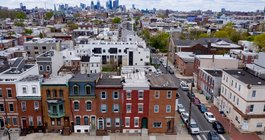
August 28, 2024
 Jeff Tomik/PhillyVoice
Jeff Tomik/PhillyVoice
Work has begun to repave the 200 block of South Camac Street, between Walnut and Locust streets, with a wooden surface.
Work began this week on a long-delayed project to repave a block of Camac Street with a wooden surface, harkening back to the 1800s when horse-drawn carriages were commonplace in Center City.
The 200 block of South Camac Street, between Walnut and Locust streets, had been the last remaining example of the city's wood-block paving method until it was torn up in 2015. At the time, the city was preparing to host Pope Francis for the World Meeting of Families.
"It was deteriorating, and so the city decided to cover it in asphalt in preparation for the visit of the pope," Paul Steinke, executive director of the Preservation Alliance for Greater Philadelphia, said Wednesday. "It was one of the measures they took to clean up the city in advance of that visit."
In the years since then, the Preservation Alliance had pushed the city to restore the wood pavement on this narrow stretch of Camac Street because it was part of an official historic district. In 1999, Philadelphia established a thematic historic street paving district to protect such roads and require that they be restored if they are damaged or destroyed.
"That block of Camac, and maybe other blocks of Camac nearby, were historically paved with wood blocks," Steinke said. "It was thought to be quieter than Belgian block or granite block, which were pretty noisy with the clatter of carriage wheels."
After the invention of the automobile, concrete and asphalt became the primary road surfacing materials in cities across the United States. Most of Philadelphia's wood-paved streets — about 20 miles by the early 20th century — were repaved in the 1920s to adjust to the advent of cars. Wood-block streets had downsides even in their heyday.
"One of the complaints was that it would soak up horse urine and become quite aromatic, which wasn't pleasant," Steinke said. "And with the dawn of automobiles, wood blocks are not really able to sustain heavy traffic. I think they can manage the occasional 2,000-pound vehicle coming down the pike, but not Market Street or Walnut Street traffic."
In 2019, Philadelphia received a $1.2 million state grant to repave four historic streets, including the 200 block of Camac Street, with their original materials. During the design phase for the project on Camac Street, engineering teams with the Streets Department raised questions about drainage and how to ensure the longevity of a modern wood-block street. They ultimately settled on a historic wood-block design plan from 1929, but the pandemic prevented the project from moving forward with its original timeline in 2021.
The paving project that's now underway will begin at the base concrete level of the street.
"As needed, an asphalt leveling base course will be applied on top of the existing concrete base to ensure proper grading for drainage with the wood blocks placed and adhered on top of either the concrete base or asphalt leveling course," Streets Department spokesperson Traves Saunders said.
Black locust wood will be used for the street surface due to its strength and rot-resistant properties. The material is often used for railroad ties, constructional timber, posts, sills and frames.
The city also is working to restore historic paving on East Mermaid Lane and Winston Road in Chestnut Hill and on Waverly Street, near South 15th Street, in Center City. The latter project will restore the original blue-glazed brick that's also seen in parts of Old City and Pennsport.
"Philadelphia is fortunate to have a number of blocks around the city that are paved in a variety of historic materials," Steinke said. "Belgian block is probably the most common. There's red brick, yellow brick."
The Camac Street project is expected to be finished by the end of the year, officials said. Once completed, the road will be open to cars passing through, although the street is too narrow for parking.
"Cars can and do use it," Steinke said. "The previous generations had durability over time. It remains to be see how long this will hold up, but I think the city traffic engineers have gone to great pains to do their best to install it in a way that gives it its best chance to survive over time."